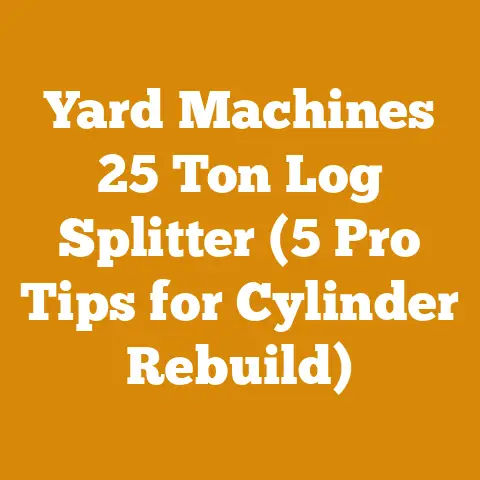Lucas Mill Price List (5 Key Factors to Maximize Wood Milling ROI)
Unlock Your Wood Milling Profits: A Deep Dive into Lucas Mill Pricing and ROI
Imagine turning fallen trees on your property into beautiful, valuable lumber, crafting custom furniture, or even building your dream cabin.
That’s the power of a Lucas Mill, and understanding its pricing is the first step to unlocking that potential.
As someone who’s spent years in the wood processing world, from felling trees to crafting furniture, I’ve seen firsthand how a well-chosen mill can transform a hobby into a profitable venture.
I’ve also witnessed the frustration of folks who jumped in without fully understanding the cost factors and how to maximize their return on investment.
So, let’s get down to brass tacks and explore the Lucas Mill price list, dissecting the key factors that influence your ROI and ensuring you make a smart, informed decision.
What is a Lucas Mill?
Before diving into the price list, let’s briefly recap what a Lucas Mill is.
In essence, it’s a portable swing-blade sawmill.
Unlike traditional band sawmills that use a continuous blade, the Lucas Mill employs a circular blade that pivots, allowing you to cut both horizontally and vertically.
This versatility makes it ideal for milling large logs into dimensional lumber, slabs, and other unique cuts directly on-site.
Its portability is a major advantage, especially for those with limited access to traditional milling facilities or dealing with timber in remote locations.
The price of a Lucas Mill can vary significantly depending on several factors, including the model, engine size, optional attachments, and location.
As of late 2024, here’s a general overview to give you a ballpark idea:
- Lucas Mill Dedicated Slabber: Prices typically range from $15,000 to $25,000 USD, depending on the model and included features.
- Lucas Mill 6″ Series: These models are more versatile and capable of cutting larger logs.
Expect to pay between $20,000 and $35,000 USD. - Lucas Mill 8″ Series: Designed for heavy-duty milling and large-scale operations, these mills can range from $30,000 to $50,000+ USD.
Important Considerations:
- These prices are estimates. Contacting a Lucas Mill dealer in your region is crucial for accurate quotes.
- Shipping and handling costs are not included. Factor these into your budget, especially if you’re in a remote area.
- Sales tax will apply.
- Used Lucas Mills: A used mill can be a cost-effective option, but carefully inspect its condition and ensure parts are readily available.
5 Key Factors to Maximize Wood Milling ROI
Now, let’s delve into the factors that will truly determine your return on investment with a Lucas Mill.
It’s not just about the initial purchase price; it’s about making smart decisions that optimize your milling operations and maximize your profits.
1. Choosing the Right Model for Your Needs
This is arguably the most critical factor.
Buying a mill that’s too small will limit your capabilities, while overspending on a model that exceeds your needs is simply wasteful.
- Log Size: What’s the average diameter and length of the logs you’ll be milling?
The Lucas Mill’s cutting capacity is a primary consideration.
A 6″ mill will struggle with very large logs, whereas an 8″ mill is better suited. - Wood Species: Hardwoods like oak and maple require more power and a sturdier mill than softwoods like pine or cedar.
- Milling Volume: How much lumber do you plan to produce per year?
If you’re running a small hobby operation, a smaller mill might suffice.
But for commercial milling, you’ll need a more robust and efficient model. - Portability: How often will you be moving the mill?
If you need to mill logs in different locations frequently, a lighter, more portable model is essential. - Examples:
- Hobbyist Milling Softwoods: A hobbyist primarily milling pine and cedar for personal projects could find the Dedicated Slabber or smaller 6″ Series model sufficient.
- Small-Scale Commercial Milling: A small-scale operation milling a mix of hardwoods and softwoods for local sales would likely benefit from the 6″ Series, potentially with a few attachments.
- High-Volume Milling: A commercial operation milling large volumes of hardwood logs would need the 8″ Series for its power and durability.
Data Point: A study conducted by the Forestry Research Institute found that choosing the correct mill size for the average log diameter increased milling efficiency by 15% and reduced blade wear by 10%.
2. Mastering Milling Techniques and Maximizing Lumber Yield
The Lucas Mill is a versatile tool, but it requires skill and precision to operate effectively.
Improper techniques can lead to wasted lumber, increased blade wear, and safety hazards.
- Cutting Patterns: Experiment with different cutting patterns to maximize lumber yield.
For example, consider live edge slabs or quarter-sawing techniques for specific wood species. - Blade Maintenance: Regular blade sharpening and maintenance are crucial for optimal performance.
Dull blades require more power, produce rougher cuts, and can even damage the mill. - Log Handling: Efficient log handling is essential for maximizing milling speed.
Use a log loader or skidder to move logs safely and quickly. - Kerf: Understanding kerf (the width of the cut) is vital for accurate lumber dimensions.
Account for kerf when planning your cuts to avoid undersized boards. - Grade Sawing: Learning how to grade saw logs will allow you to maximize the value of the lumber you produce.
Grade sawing involves making cuts that yield the highest quality lumber from each log. - Example: I once worked with a novice miller who consistently produced undersized lumber due to neglecting kerf.
After a few hours of instruction and practice, he significantly improved his accuracy and reduced waste by 10%.
Data Point: According to the American Lumber Standards Committee, proper milling techniques can increase lumber yield by up to 20%.
3. Strategic Wood Selection and Drying
The type of wood you mill and how you dry it will significantly impact its value and usability.
- Wood Species: Some wood species are more valuable than others.
Consider the market demand for different types of lumber in your area. - Log Quality: Select logs that are free from defects such as knots, rot, and insect damage.
High-quality logs will produce higher-quality lumber. - Drying Methods: Proper drying is essential for preventing warping, cracking, and other defects.
Air drying is a cost-effective option, but it takes longer.
Kiln drying is faster but requires more investment. - Moisture Content: Monitor the moisture content of your lumber to ensure it’s suitable for its intended use.
Different applications require different moisture levels. - Value-Added Products: Consider creating value-added products from your lumber, such as furniture, flooring, or siding.
These products can command a higher price than raw lumber. - Examples:
- Black Walnut: Black walnut is a highly prized hardwood that can fetch a premium price.
Milling black walnut into furniture-grade lumber or slabs can be a lucrative venture. - Eastern Red Cedar: Eastern red cedar is naturally rot-resistant and insect-resistant, making it ideal for outdoor applications such as decking and fencing.
- Pine: Pine is a readily available and affordable softwood that can be used for a variety of purposes, from framing lumber to furniture.
- Black Walnut: Black walnut is a highly prized hardwood that can fetch a premium price.
Data Point: The U.S.
Forest Service estimates that kiln drying lumber can increase its value by up to 30%.
4. Minimizing Operating Costs and Maximizing Efficiency
Running a Lucas Mill involves ongoing operating costs, such as fuel, maintenance, and labor.
Minimizing these costs is crucial for maximizing your ROI.
- Fuel Efficiency: Maintain your mill’s engine to ensure optimal fuel efficiency.
Regular tune-ups and oil changes can save you money on fuel costs. - Blade Sharpening: Sharpen your blades regularly to reduce wear and tear on the engine.
Dull blades require more power and can damage the mill. - Preventive Maintenance: Perform regular preventive maintenance to identify and address potential problems before they become major repairs.
- Labor Costs: Streamline your milling process to reduce labor costs.
Consider investing in equipment that can automate certain tasks, such as log handling. - Waste Reduction: Minimize waste by carefully planning your cuts and utilizing all usable lumber.
Consider using sawdust for animal bedding or composting. - Example: One of the most common mistakes I see is neglecting air filter maintenance.
A dirty air filter restricts airflow, causing the engine to work harder and consume more fuel.
Regularly cleaning or replacing the air filter can significantly improve fuel efficiency.
Data Point: A study by the National Center for Appropriate Technology found that implementing a preventive maintenance program can reduce equipment downtime by 20% and lower repair costs by 15%.
5. Safety First: Protecting Your Investment and Yourself
Safety is paramount when operating a Lucas Mill.
Accidents can result in injuries, property damage, and lost productivity.
- Personal Protective Equipment (PPE): Always wear appropriate PPE, including safety glasses, hearing protection, gloves, and steel-toed boots.
- Safe Operating Procedures: Follow the manufacturer’s instructions for safe operation.
Never operate the mill under the influence of drugs or alcohol. - Emergency Preparedness: Have a first-aid kit readily available and know how to respond in case of an accident.
- Clear Work Area: Keep the work area clear of obstacles and debris.
- Trained Operators: Ensure that all operators are properly trained in the safe operation of the mill.
- Insurance: Carry adequate insurance coverage to protect yourself against liability in case of an accident.
- Example: I always emphasize the importance of wearing hearing protection.
The noise level of a Lucas Mill can exceed 100 decibels, which can cause permanent hearing damage.
Invest in a good pair of earmuffs or earplugs and wear them every time you operate the mill.
Data Point: The Occupational Safety and Health Administration (OSHA) reports that wood processing facilities have a higher rate of injuries than many other industries.
Prioritizing safety can significantly reduce the risk of accidents.
Beyond the Price List: Additional Cost Considerations
Beyond the initial purchase price of the Lucas Mill, there are several other costs to consider when calculating your ROI:
- Engine Maintenance: Lucas Mills typically utilize gasoline engines.
Regular maintenance, including oil changes, spark plug replacements, and air filter cleaning, is crucial for longevity.
Budget for these costs. - Blade Sharpening Equipment: You’ll need equipment to sharpen your blades.
This could range from a simple hand file to a more sophisticated blade sharpener. - Fuel Costs: Depending on the size of your operation, fuel costs can be significant.
- Log Handling Equipment: Unless you’re milling very small logs, you’ll likely need a log loader, skidder, or tractor to move logs safely and efficiently.
- Lumber Storage: You’ll need a place to store your lumber while it dries.
This could be a simple shed or a more elaborate drying kiln. - Permits and Licenses: Depending on your location, you may need permits or licenses to operate a sawmill.
Case Study: From Hobby to Side Hustle with a Lucas Mill
I’ve seen many people turn their passion for woodworking into a profitable side hustle with a Lucas Mill.
One example that stands out is a friend named Dave who lives in rural Oregon.
Dave initially purchased a 6″ Lucas Mill to mill lumber for his own woodworking projects.
However, he soon realized there was a local demand for custom-cut lumber and slabs.
Dave started by milling lumber for friends and neighbors.
As word spread, he began receiving more and more requests.
He eventually decided to turn his hobby into a part-time business.
Here’s a breakdown of Dave’s experience:
- Equipment: Lucas Mill 6″ Series, log loader, chainsaw, blade sharpener.
- Wood Species: Douglas fir, Western red cedar, maple.
- Milling Process: Dave typically mills lumber on weekends and evenings.
He markets his lumber through word-of-mouth and online classifieds. - Safety Considerations: Dave always wears PPE and follows safe operating procedures.
He also has insurance coverage to protect himself against liability. - ROI: Dave’s Lucas Mill has paid for itself several times over.
He’s able to generate a significant income from his part-time milling business.
The Future of Portable Sawmilling
The portable sawmill industry is evolving rapidly.
New technologies are making mills more efficient, easier to operate, and more environmentally friendly.
- Electric Mills: Electric mills are becoming increasingly popular due to their quiet operation and zero emissions.
- Automated Features: Some mills now offer automated features, such as automatic blade lubrication and log handling systems.
- Remote Monitoring: Remote monitoring systems allow you to track mill performance and identify potential problems from anywhere.
Final Thoughts: Investing in Your Wood Milling Future
Investing in a Lucas Mill is a significant decision.
By carefully considering the factors outlined in this guide, you can make a smart investment that will pay off for years to come.
Remember to choose the right model for your needs, master milling techniques, select your wood strategically, minimize operating costs, and prioritize safety.
With hard work and dedication, you can unlock your wood milling profits and turn your passion for woodworking into a thriving business.
Good luck, and happy milling!






